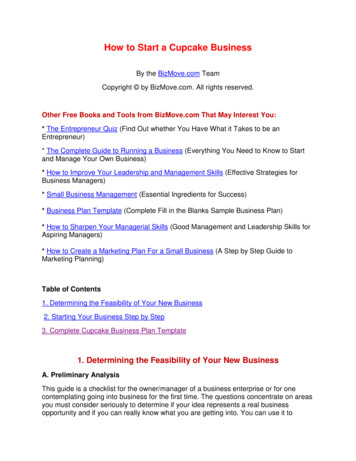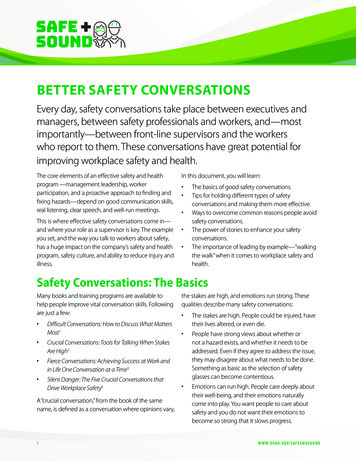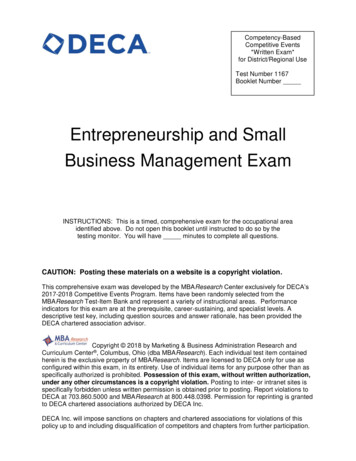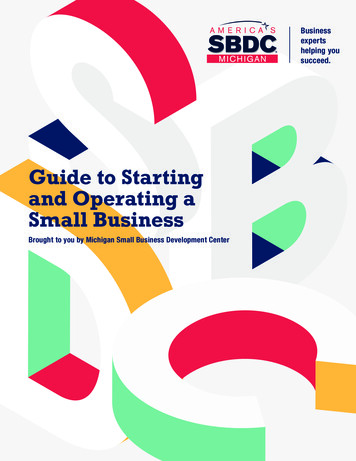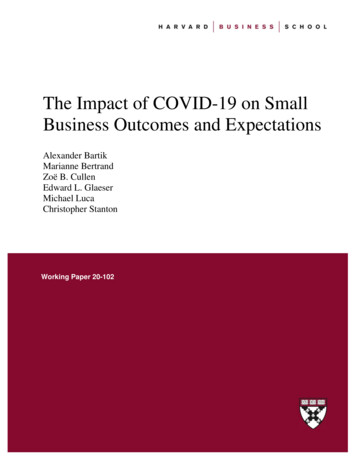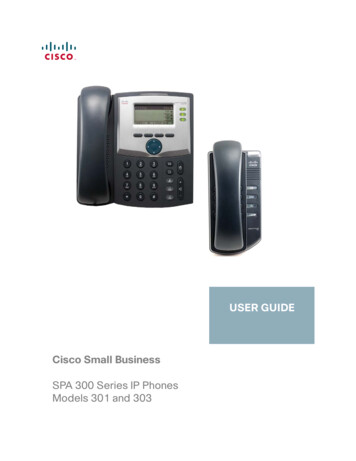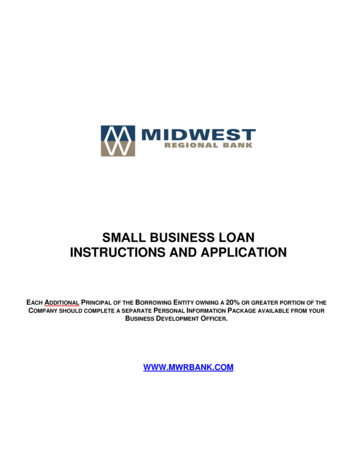
Transcription
Small Business Safetyand Health Handbook
Small Business Safetyand Health HandbookDHHS (NIOSH) Publication Number 2021-120 OSHA Publication Number 2209-07R 2021
ContentsAbout this Handbook . . . . . . . . . . . . . . . . . . . . . . . . . . . . . . . . . . . . . . . . . . . . . . . . . . . . . . . . . . . . . . . . . . . . . . . . . . 1Safety and Health Programs . . . . . . . . . . . . . . . . . . . . . . . . . . . . . . . . . . . . . . . . . . . . . . . . . . . . . . . . . . . . . . . . . . . 2Value of a Safety and Health Program . . . . . . . . . . . . . . . . . . . . . . . . . . . . . . . . . . . . . . . . . . . . . . . . . . . . . . . . . . . . . . . 2Implementing a Safety and Health Program . . . . . . . . . . . . . . . . . . . . . . . . . . . . . . . . . . . . . . . . . . . . . . . . . . . . . . . . . 3Workplace Self-Inspection . . . . . . . . . . . . . . . . . . . . . . . . . . . . . . . . . . . . . . . . . . . . . . . . . . . . . . . . . . . . . . . . . . . . . 4Self-Inspection Checklists . . . . . . . . . . . . . . . . . . . . . . . . . . . . . . . . . . . . . . . . . . . . . . . . . . . . . . . . . . . . . . . . . . . . . . 4General . . . . . . . . . . . . . . . . . . . . . . . . . . . . . . . . . . . . . . . . . . . . . . . . . . . . . . . . . . . . . . . . . . . . . . . . . . . . . . . . . . . . . . . . . . . . 5Safety and Health Programs . . . . . . . . . . . . . . . . . . . . . . . . . . . . . . . . . . . . . . . . . . . . . . . . . . . . . . . . . . . . . . . . . . . . . . 5General Work Environment and Housekeeping . . . . . . . . . . . . . . . . . . . . . . . . . . . . . . . . . . . . . . . . . . . . . . . . . . . . 7Posting of Required Safety and Health Information . . . . . . . . . . . . . . . . . . . . . . . . . . . . . . . . . . . . . . . . . . . . . . . . 9Recordkeeping and Reporting . . . . . . . . . . . . . . . . . . . . . . . . . . . . . . . . . . . . . . . . . . . . . . . . . . . . . . . . . . . . . . . . . . . 10Compressed Gas Cylinders . . . . . . . . . . . . . . . . . . . . . . . . . . . . . . . . . . . . . . . . . . . . . . . . . . . . . . . . . . . . . . . . . . . . . . . . 12Electrical Safety . . . . . . . . . . . . . . . . . . . . . . . . . . . . . . . . . . . . . . . . . . . . . . . . . . . . . . . . . . . . . . . . . . . . . . . . . . . . . . . . . . . 13Exit Routes and Emergency Planning . . . . . . . . . . . . . . . . . . . . . . . . . . . . . . . . . . . . . . . . . . . . . . . . . . . . . . . . . . . . . . 17Doors . . . . . . . . . . . . . . . . . . . . . . . . . . . . . . . . . . . . . . . . . . . . . . . . . . . . . . . . . . . . . . . . . . . . . . . . . . . . . . . . . . . . . . . . . . . 17Emergency Action Plans . . . . . . . . . . . . . . . . . . . . . . . . . . . . . . . . . . . . . . . . . . . . . . . . . . . . . . . . . . . . . . . . . . . . . . . . . 19Exits, Exit Paths (Means of Egress) . . . . . . . . . . . . . . . . . . . . . . . . . . . . . . . . . . . . . . . . . . . . . . . . . . . . . . . . . . . . . . . . 22Fire Protection . . . . . . . . . . . . . . . . . . . . . . . . . . . . . . . . . . . . . . . . . . . . . . . . . . . . . . . . . . . . . . . . . . . . . . . . . . . . . . . . . . . . 24Fire Extinguishers . . . . . . . . . . . . . . . . . . . . . . . . . . . . . . . . . . . . . . . . . . . . . . . . . . . . . . . . . . . . . . . . . . . . . . . . . . . . . . . 24Fire Suppression and Alarm Systems . . . . . . . . . . . . . . . . . . . . . . . . . . . . . . . . . . . . . . . . . . . . . . . . . . . . . . . . . . . . . 25Flammable and Combustible Liquids and Materials . . . . . . . . . . . . . . . . . . . . . . . . . . . . . . . . . . . . . . . . . . . . . . 26Hand and Portable Powered Tools and Equipment . . . . . . . . . . . . . . . . . . . . . . . . . . . . . . . . . . . . . . . . . . . . . . . . . 28Explosive (Powder) Actuated Fastening Tools . . . . . . . . . . . . . . . . . . . . . . . . . . . . . . . . . . . . . . . . . . . . . . . . . . . . 28Hand Tools and Equipment . . . . . . . . . . . . . . . . . . . . . . . . . . . . . . . . . . . . . . . . . . . . . . . . . . . . . . . . . . . . . . . . . . . . . . 29Portable (Power Operated) Tools and Equipment . . . . . . . . . . . . . . . . . . . . . . . . . . . . . . . . . . . . . . . . . . . . . . . . . 31Hazard Communication and Chemicals . . . . . . . . . . . . . . . . . . . . . . . . . . . . . . . . . . . . . . . . . . . . . . . . . . . . . . . . . . . . 32Hazard Communication . . . . . . . . . . . . . . . . . . . . . . . . . . . . . . . . . . . . . . . . . . . . . . . . . . . . . . . . . . . . . . . . . . . . . . . . . 32Hazardous Chemicals . . . . . . . . . . . . . . . . . . . . . . . . . . . . . . . . . . . . . . . . . . . . . . . . . . . . . . . . . . . . . . . . . . . . . . . . . . . 34iii SMALL BUSINESS SAFETY AND HEALTH HANDBOOK
Lockout/Tagout Procedures . . . . . . . . . . . . . . . . . . . . . . . . . . . . . . . . . . . . . . . . . . . . . . . . . . . . . . . . . . . . . . . . . . . . . . . 36Machinery and Machine Guarding . . . . . . . . . . . . . . . . . . . . . . . . . . . . . . . . . . . . . . . . . . . . . . . . . . . . . . . . . . . . . . . . . 38Abrasive Wheel Equipment Grinders . . . . . . . . . . . . . . . . . . . . . . . . . . . . . . . . . . . . . . . . . . . . . . . . . . . . . . . . . . . . . 38Machinery and Equipment . . . . . . . . . . . . . . . . . . . . . . . . . . . . . . . . . . . . . . . . . . . . . . . . . . . . . . . . . . . . . . . . . . . . . . 40Materials Handling and Storage . . . . . . . . . . . . . . . . . . . . . . . . . . . . . . . . . . . . . . . . . . . . . . . . . . . . . . . . . . . . . . . . . . . 43Hoist and Auxiliary Equipment . . . . . . . . . . . . . . . . . . . . . . . . . . . . . . . . . . . . . . . . . . . . . . . . . . . . . . . . . . . . . . . . . . 43Materials Handling . . . . . . . . . . . . . . . . . . . . . . . . . . . . . . . . . . . . . . . . . . . . . . . . . . . . . . . . . . . . . . . . . . . . . . . . . . . . . . 46Powered Industrial Trucks . . . . . . . . . . . . . . . . . . . . . . . . . . . . . . . . . . . . . . . . . . . . . . . . . . . . . . . . . . . . . . . . . . . . . . . 47Medical Services and First Aid . . . . . . . . . . . . . . . . . . . . . . . . . . . . . . . . . . . . . . . . . . . . . . . . . . . . . . . . . . . . . . . . . . . . . 49Noise Exposure . . . . . . . . . . . . . . . . . . . . . . . . . . . . . . . . . . . . . . . . . . . . . . . . . . . . . . . . . . . . . . . . . . . . . . . . . . . . . . . . . . . 51Permit-Required Confined Spaces . . . . . . . . . . . . . . . . . . . . . . . . . . . . . . . . . . . . . . . . . . . . . . . . . . . . . . . . . . . . . . . . . 53Personal Protective Equipment (PPE) . . . . . . . . . . . . . . . . . . . . . . . . . . . . . . . . . . . . . . . . . . . . . . . . . . . . . . . . . . . . . . 56Respiratory Protection . . . . . . . . . . . . . . . . . . . . . . . . . . . . . . . . . . . . . . . . . . . . . . . . . . . . . . . . . . . . . . . . . . . . . . . . . . . . 58Walking-Working Surfaces . . . . . . . . . . . . . . . . . . . . . . . . . . . . . . . . . . . . . . . . . . . . . . . . . . . . . . . . . . . . . . . . . . . . . . . . 60Elevated Surfaces . . . . . . . . . . . . . . . . . . . . . . . . . . . . . . . . . . . . . . . . . . . . . . . . . . . . . . . . . . . . . . . . . . . . . . . . . . . . . . . 60Floor Holes and Wall Openings . . . . . . . . . . . . . . . . . . . . . . . . . . . . . . . . . . . . . . . . . . . . . . . . . . . . . . . . . . . . . . . . . . 61Portable Ladders . . . . . . . . . . . . . . . . . . . . . . . . . . . . . . . . . . . . . . . . . . . . . . . . . . . . . . . . . . . . . . . . . . . . . . . . . . . . . . . . 62Stairs and Stairways . . . . . . . . . . . . . . . . . . . . . . . . . . . . . . . . . . . . . . . . . . . . . . . . . . . . . . . . . . . . . . . . . . . . . . . . . . . . . 64Walkways . . . . . . . . . . . . . . . . . . . . . . . . . . . . . . . . . . . . . . . . . . . . . . . . . . . . . . . . . . . . . . . . . . . . . . . . . . . . . . . . . . . . . . . 65Welding, Cutting, and Brazing . . . . . . . . . . . . . . . . . . . . . . . . . . . . . . . . . . . . . . . . . . . . . . . . . . . . . . . . . . . . . . . . . . . . . 67Safety and Health Assistance for Small Businesses . . . . . . . . . . . . . . . . . . . . . . . . . . . . . . . . . . . . . . . . . . . . . 71OSHA Resources . . . . . . . . . . . . . . . . . . . . . . . . . . . . . . . . . . . . . . . . . . . . . . . . . . . . . . . . . . . . . . . . . . . . . . . . . . . . . . . . . . 71Whistleblower Program: Protection from Retaliation . . . . . . . . . . . . . . . . . . . . . . . . . . . . . . . . . . . . . . . . . . . . . . . 74State Plans . . . . . . . . . . . . . . . . . . . . . . . . . . . . . . . . . . . . . . . . . . . . . . . . . . . . . . . . . . . . . . . . . . . . . . . . . . . . . . . . . . . . . . . . 75National Institute for Occupational Safety and Health (NIOSH) Resources . . . . . . . . . . . . . . . . . . . . . . . . . . . 75Other Resources . . . . . . . . . . . . . . . . . . . . . . . . . . . . . . . . . . . . . . . . . . . . . . . . . . . . . . . . . . . . . . . . . . . . . . . . . . . . . . . . . . 76The Small Business Regulatory Enforcement Fairness Act of 1996 (SBREFA) . . . . . . . . . . . . . . . . . . . . . . . . . . 76OSHA Regional Offices . . . . . . . . . . . . . . . . . . . . . . . . . . . . . . . . . . . . . . . . . . . . . . . . . . . . . . . . . . . . . . . . . . . . . . . . 77Contact OSHA . . . . . . . . . . . . . . . . . . . . . . . . . . . . . . . . . . . . . . . . . . . . . . . . . . . . . . . . . . . . . . . . . . . . . . . . . . . . . . . . 78iv SMALL BUSINESS SAFETY AND HEALTH HANDBOOK
About this HandbookThe Occupational Safety and HealthAdministration (OSHA) and the National Institutefor Occupational Safety and Health (NIOSH)developed this handbook to provide smallbusiness employers with workplace safety andhealth information.The handbook summarizes the benefits of aneffective safety and health program, providesself-inspection checklists for employers to identifyworkplace hazards, and reviews key workplacesafety and health resources for small businesses.This handbook is a general guide. Employersshould not use it to assess compliance with theOccupational Safety and Health Act of 1970 (OSHAct) or federal OSHA standards. This handbookdoes not provide legal interpretations of therequirements in OSHA standards, nor does itcreate any additional compliance requirementsfor employers. OSHA will not cite employersunder the General Duty Clause in Section 5(a)(1)of the OSH Act for not following the handbook’srecommendations.More than 20 states and territories operate theirown OSHA-approved State Plans. A list of statesthat operate their own State Plans can be foundon OSHA’s website. While the safety and healthcompliance requirements in these State Plansmay differ in some respects from federal OSHArequirements, employers in all states may benefitfrom using this handbook.This publication is in the public domain andcopyright-free. You can share it, fully or partially,without permission. We appreciate, but do notrequire, source credit.Photo: iStock1 SMALL BUSINESS SAFETY AND HEALTH HANDBOOK
Safety and Health ProgramsValue of a Safety andHealth Programin a safety and health program now will helpyou avoid possible losses in the future. A safebusiness is a sound business.Every year, more than 5,000 workers are killedon the job (average of 14 deaths per day), andmore than 3.6 million suffer a serious job-relatedinjury or illness. Even one serious workplaceinjury or illness can have a devastating impacton a small business, including costs associatedwith higher workers’ compensation premiums,medical expenses, legal fees, replacement workertraining, lost productivity, equipment repairs,and lower worker morale – to say nothing of theoverwhelming personal impacts.The main goal of a safety and health program is toprevent workplace injuries, illnesses, and deaths,as well as the suffering and financial hardshipthese events can cause for workers, their families,and employers. Traditional approaches are oftenreactive; that is, problems are addressed onlyafter a worker is injured or becomes sick, a newstandard or regulation is published, or an outsideinspection finds a problem.OSHA’s Safe Sound campaign encouragesevery workplace to have a safety and healthprogram. Through this campaign, OSHA workswith NIOSH and other organizations to provideresources to help employers develop safety andhealth programs and to recognize the successesof these programs.Implementing a safety and health programhelps businesses: Prevent workplace injuries and illnessesImprove compliance with laws and regulationsReduce costs, including significant reductionsin workers’ compensation premiumsEngage workersEnhance social responsibility goalsIncrease productivity and enhance overallbusiness operationsSmall employers like you place a high value onOSHA and NIOSH provide helpful resources andwant to work with you to promote a safe andhealthful workplace. Employers that make jobsafety and health a real part of their everydayoperations will benefit in the long run. Investing2 SMALL BUSINESS SAFETY AND HEALTH HANDBOOKPhoto: iStockthe well-being of your workers. Like many smallbusinesses, you may employ family members andpersonal acquaintances. And, if you don’t knowyour workers before they are hired, the size of yourworkplace will promote the closeness and concernfor one another that small businesses value.
Implementing a Safety andHealth Program Management leadershipWorker participationHazard identification and assessmentHazard prevention and controlEducation and trainingProgram evaluation and improvementCommunication and coordination for hostemployers, contractors, and staffing agenciesOSHA’s website includes tools to help employersimplement safety and health programs, including: how to get started,a safety and health programself‑evaluation tool,a safety and health programimplementation checklist, anda safety and health program audit tool.You can begin with a basic program, set simplegoals, and grow from there. If you focus onachieving goals, monitoring performance,and evaluating outcomes, your workplacecan progress to higher levels of safety andhealth achievement.3 SMALL BUSINESS SAFETY AND HEALTH HANDBOOKPhoto: iStockOSHA’s Recommended Practices for Safetyand Health Programs use a proactive approachto managing workplace safety and health,recognizing that finding and fixing hazardsbefore they cause injury or illness is a farmore effective approach. The RecommendedPractices present a step-by-step approach toimplementing a successful safety and healthprogram, built around seven core elements:By developing and implementing a safetyand health program, you are expressing anddocumenting your good faith and commitmentto protecting your workers’ health and safety.Doing so does not usually require additionalworkers or high costs. You can integrate safetyand health into your other business functionswith modest effort.The key to a successful safety and health programis to see it as a part of your day-to-day businessoperation. As you incorporate it into your businessculture, safety and health awareness will becomesecond nature to you and your workers, leading toa safe and sound business.Every workplace should have a safety and healthprogram that includes management leadership,worker participation, and a systematic approachto finding and fixing hazards. Regular workplaceinspections are an important tool for identifyinghazards and fixing them.
Workplace Self-InspectionAn effective way to identify workplace hazardsis for knowledgeable and experienced workersto conduct routine safety and health inspections(i.e., self-inspections). The only way to know ifpotential hazards exist and if they are undercontrol is to assess work processes directly.Small business employers should conductroutine workplace self-inspections to: identify hazards,control identified hazards, andmonitor and evaluate hazard controls to verifythat they continue to be effective.Consultants from OSHA’s On-Site Consultationprograms in all states, the District of Columbiaand most territories can help small businessemployers with this process at no cost.Self-Inspection ChecklistsCompile information from your completedchecklists with workplace injury and illnessrecords, worker training information, and processand equipment information (e.g., maintenancelogs, failure incident reports) to help youdetermine where challenges exist. Refer to OSHAstandards, resources on the OSHA website, andother resources listed in this handbook to findsolutions to those challenges. At the end ofeach checklist, you will find a link to additionalresources on that topic.4 SMALL BUSINESS SAFETY AND HEALTH HANDBOOKThese checklists are not all-inclusive andnot all of the checklists will apply to yourbusiness. You might want to start by selectingthe checklists that apply to areas that are mostcritical to your business, then expanding yourchecklists over time to cover all areas that pertainto your business. Consider adding or deletingitems from a checklist to more accurately coveryour work processes.Photo: iStockThe checklists in the handbook are intendedfor general industry workplaces, but not forconstruction or maritime industries. They are astarting point for identifying workplace hazards.The checklists can give you some indicationof where to begin taking action to make yourbusiness safer and more healthful for yourworkers. The checklists are based on severalsources, including OSHA standards and generallyaccepted safety and health principles. Do not usethe checklists to assess your compliance with theOSH Act or OSHA standards.
Company name:Worksite:Specific worksite area:Inspected by:Date:GeneralSafety and Health ProgramsYesNoN/AA safety and health program is in place tohelp proactively manage safety and health inthe workplace. Safety and health is a top priority. Safety and health is a part of dailyconversations with workers. A procedure is in place for workers to reportinjuries, illnesses, incidents (including nearmisses/close calls), hazards, and safety andhealth concerns. Workers are trained how to identify andcontrol hazards. Workplace inspections are conductedwith workers. Workers are asked for ideas onhazard control. Workers are assigned the task of choosing,implementing, and evaluating hazardcontrols they come up with. 5 SMALL BUSINESS SAFETY AND HEALTH HANDBOOKComments
Safety and Health ProgramsYesNoN/AForeseeable emergency scenarios areidentified and instructions are developedon what to do in each case. Workers are consulted before significantchanges are made to the workplace, workorganization, equipment, or materials in orderto identify potential safety or health issues. Time is set aside to discuss safety and healthissues, with the goal of identifying ways toimprove the safety and health program. CommentsAdditional Resources OSHA: Recommended Practices for Safety and Health ProgramsOSHA: afety Pays ProgramAmerican Society of Safety Professionals: Guidance Manual — Keep Your People Safe inSmaller Organizations (GM-Z10.101)6 SMALL BUSINESS SAFETY AND HEALTH HANDBOOKReset Form
General Work Environmentand HousekeepingYesNoN/AThe workplace is clean, orderly, and sanitary. Workplace floors are maintained in adry condition. Where wet processes are used, drainageis maintained and false floors, platforms,mats, or other dry standing places areprovided, where practicable, or workers useappropriate footwear. Enclosed workplaces are maintained toprevent the entrance or harborage of rodents,insects, and other vermin; and a continuingand effective extermination program isinstituted where their presence is detected. Workers do not eat or drink in any areaswhere hazardous substances are present. Combustible scrap, debris, and waste arestored properly and promptly removed fromthe workplace. Covered metal waste cans are used for ragssoaked in oil, flammable/combustible liquid,paint, etc. Vacuuming and non-vigorous sweepingare used in place of blowing down withcompressed air. When it is necessary to blow down in placeof vacuuming and sweeping, compressed airpressure is limited to 30 psi, and dust cloudsare kept to a minimum. 7 SMALL BUSINESS SAFETY AND HEALTH HANDBOOKComments
General Work Environmentand HousekeepingYesNoN/AGeneral dilution or local exhaust ventilationsystems are used to control dusts, vapors,gases, fumes, smoke, solvents, or mistsgenerated in the workplace, where possible. Clear space is maintained in front of electricalpanels; minimum 3 feet in front, and at least thewidth of the panel, but not less than 2 ½ feet. Appropriate precautions are taken to maintainexits, and protect workers during construction,renovation, and repair operations. CommentsAdditional Resources OSHA Regulations: OSHA: Restrooms and Sanitation RequirementsOSHA: Indoor Air QualityNIOSH: Indoor Environmental QualityNIOSH: Office Environment– 29 CFR 1910.22, General Requirements for Walking and Working Surfaces– 29 CFR 1910.36, Design and Construction Requirements for Exit Routes– 29 CFR 1910.37, Maintenance, Safeguards, and Operational Features for Exit Routes– 29 CFR 1910.141, Sanitation8 SMALL BUSINESS SAFETY AND HEALTH HANDBOOKReset Form
Posting of Required Safety andHealth InformationYesNoN/A The annual Summary of Work-RelatedInjuries and Illnesses (OSHA Form 300A)is posted during the months of February,March, and April. Any citations resulting from OSHA workplaceinspections are posted until the violationhas been abated, or for three working days,whichever is later. Emergency telephone numbers areposted where they can be readily foundin case of emergency. CommentsThe required OSHA Job Safety and HealthPoster (or state plan equivalent) is posted in aprominent location in the workplace.NOTE: The poster is available for free fromOSHA in multiple languages. While OSHAdoes not require employers to displaythe poster in other languages, OSHAencourages employers with employees thatspeak other languages to also display theposter in those languages.Additional Resources OSHA Regulations: OSHA: Free Workplace Poster – Job Safety and Health – It’s the Law!– 29 CFR 1903.2, Posting of OSHA Notice– 29 CFR 1903.16, Posting of Citations9 SMALL BUSINESS SAFETY AND HEALTH HANDBOOKReset Form
Recordkeeping and ReportingYesNoN/A A supplementary record of each recordableoccupational injury and illness is prepared forrecordable cases on OSHA Form 301 (Injuryand Illness Incident Report). Employers canuse equivalent forms that provide all theinformation on the OSHA Form 301. An annual summary is prepared at the endof each calendar year using OSHA Form300A (Summary of Work-Related Injuriesand Illnesses). Occupational injuries or illnesses, exceptminor injuries requiring only first aid,are recorded on OSHA Form 300 (Log ofWork‑Related Injuries and Illnesses).NOTE: Employers are partially exempt fromOSHA’s injury and illness recordkeepingrequirements if 1) they had 10 or fewerworkers during all of the last calendaryear (see 29 CFR 1904.1), or 2) they are incertain low-hazard industries (see 29 CFRPart 1904, Subpart B, Appendix A). Allemployers, regardless of size or industry,must report work-related fatalities, in-patienthospitalizations, amputations, and loss of aneye to OSHA.You must electronically submit informationfrom your Form 300A Summary to OSHAannually (by March 2 of the year after thecalendar year covered by the form) if: You have an establishment with 250 ormore workers that is currently required tokeep OSHA injury and illness records, or You have an establishment with 20249 workers that is classified in certainindustries with historically high rates ofoccupational injuries and illnesses.10 SMALL BUSINESS SAFETY AND HEALTH HANDBOOKComments
Recordkeeping and ReportingYesNoN/AInjury and illness records (OSHA 300, 300A,and 301) are kept at the worksite for at leastfive years. Worker medical and exposure records areretained for the time period required for eachspecific type of record. Worker training records are kept andaccessible for review by workers, as requiredby OSHA standards. All work-related fatalities are reportedto OSHA within 8 hours. All work-relatedin‑patient hospitalizations, amputations,and loss of an eye are reported to OSHAwithin 24 hours. CommentsAdditional Resources OSHA Regulations:– 29 CFR 1904, Recording and Reporting Occupational Injuries and Illness– 29 CFR 1910.1020, Access to Employee Exposure and Medical RecordsOSHA: Injury and Illness Recordkeeping and Reporting RequirementsOSHA: Report a Fatality or Severe InjuryOSHA: Access to Medical and Exposure Records11 SMALL BUSINESS SAFETY AND HEALTH HANDBOOKReset Form
Compressed Gas CylindersCompressed Gas CylindersYesNoN/ACylinders are clearly marked to identifytheir contents. Cylinders are stored where they cannotbe damaged by passing or fallingobjects, and not subject to tampering byunauthorized persons. Cylinders are regularly examined for obvioussigns of defects, deep rusting, and leakage. Care is used in handling and storage ofcylinders, safety valves, relief valves, etc.,to prevent damage. Care is taken to not drop or strike cylinders. Cylinders without fixed wheels have keys,handles, or non-adjustable wrenches onstem valves when in service. Liquefied gases are stored and shipped valveend up with valve-protection caps in place. Valve-protection caps are placed oncylinders when the cylinders are not in use,or connected for use. Valves are closed before cylinders aremoved, when cylinders are empty, and atthe completion of each job. Empty cylinders are appropriately markedand their valves are closed. CommentsAdditional Resources OSHA Regulations:– 29 CFR 1910.101, Compressed Gases– 29 CFR 1910.110, Storage and Handling of Liquid Petroleum GasesOSHA: Compressed Gas and Equipment12 SMALL BUSINESS SAFET
business is a sound business . The main goal of a safety and health program is to . prevent workplace injuries, illnesses, and deaths, as well as the suffering and financial hardship . these events can cause for workers, their families, and employers . Traditional approaches

